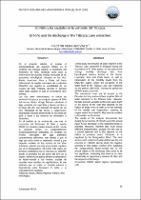| dc.contributor.author | Vera Arévalo, Héctor Alberto | |
| dc.date.accessioned | 2021-07-06T16:50:54Z | |
| dc.date.available | 2021-07-06T16:50:54Z | |
| dc.date.issued | 2009 | |
| dc.identifier.uri | https://hdl.handle.net/20.500.12542/1082 | |
| dc.description.abstract | En el presente estudio, se evalúa el comportamiento del régimen hídrico en la vertiente del Titicaca durante la ocurrencia del fenómeno El Niño, teniendo como base la información de caudales medios mensuales de las estaciones hidrológicas ubicadas en los ríos: Ramis, Huancané, Ilave y Coata, así como información de niveles mensuales de la estación ENAFER que registra la variabilidad de los niveles del lago Titicaca, durante el período 1959–2006 durante el cual se presentaron diez eventos. Los ríos antes mencionados, se ubican en territorio Peruano y, en conjunto aportan el 96% del recurso hídrico al lago Titicaca, asimismo el lago, presenta una superficie y tirante variable a lo largo del año, que depende del aporte de los ríos, intensidad de las lluvias y evaporación, alcanzando mayores dimensiones en los meses de abril a mayo y las menores en noviembre o diciembre. En el análisis se ha establecido, que ante la ocurrencia del fenómeno El Niño o evento ENSO, los caudales medios anuales de los ríos de la vertiente tienen un comportamiento predominantemente deficitario, sin embargo los niveles mensuales del lago presentan características diferentes, esto debido a que el lago que actúa como un reservorio natural y que depende también de los aportes de los años anteriores, además que este se encuentra regulado por el río Desaguadero. El evento más severo en términos deficitarios fue el ocurrido en 1982/83, donde la anomalía fue del orden del 50% en la región. Asimismo al aplicar el test no paramétrico de Mann-Kendal a los valores anuales de caudales estos resultan no significativos, lo que indicaría que no existe un relación univoca o dependencia entre fenómeno El Niño y la respuesta de los caudales. | es_PE |
| dc.description.abstract | In this study the behavior of water regimen in the Titicaca Lake watershed is analyzed during the occurrence of El Niño events, on the basis of the average monthly discharge data from hydrological stations located in the Ramis, Huancané, Ilave and Coata rivers, as well as information of the monthly levels from the ENAFER station, where the variability in the water level of the Titicaca Lake was registered for the period 1959-2006. During this period ten El Niño events occurred. The considered rivers are all located at the Peruvian territory and contribute together 96% of water resources to the Titicaca Lake. Likewise, the lake presents variable surface and water depth in the course of the year that depends on the inflow of these rivers as well as on the intensity of the rainfall and evaporation, reaching its largest extent from April to May and the smallest in November or December. The results of the analysis demonstrate that during the occurrence of El Niño event the annual mean fluvial discharge in the watershed tends to decrease. However, monthly lake level shows different characteristics, because the lake acts as a natural reservoir and it also depends on the inflow of previous years. Moreover, it is regulated by the Desaguadero River. The most severe event in terms of water deficit was the one occurred in 1982/83, during which the negative anomaly in this region reached 50%. Applying the nonparametric Mann-Kendal test to the annual values of the discharge, they prove to be not significant, indicating that there is no clear relationship or dependency between El Nino and the response of discharge. | en_US |
| dc.format | application/pdf | es_PE |
| dc.language.iso | spa | es_PE |
| dc.publisher | Servicio Nacional de Meteorología e Hidrología del Perú | es_PE |
| dc.relation.uri | https://web2.senamhi.gob.pe/rpga/pdf/2009_vol01/art4.pdf | es_PE |
| dc.rights | info:eu-repo/semantics/openAccess | es_PE |
| dc.rights | Atribución-NoComercial-SinDerivadas 3.0 Estados Unidos de América | * |
| dc.rights.uri | http://creativecommons.org/licenses/by-nc-nd/3.0/us/ | * |
| dc.source | Repositorio Institucional - SENAMHI | es_PE |
| dc.source | Servicio Nacional de Meteorología e Hidrología del Perú | es_PE |
| dc.subject | ENSO | es_PE |
| dc.subject | Cuencas | es_PE |
| dc.subject | Caudal | es_PE |
| dc.subject | Hidrometría | es_PE |
| dc.title | El Niño y los caudales en la vertiente del Titicaca | es_PE |
| dc.title.alternative | El Niño and the discharge in the Titicaca Lake watershed | es_PE |
| dc.type | info:eu-repo/semantics/article | es_PE |
| dc.identifier.journal | Revista Peruana Geo-Atmosférica | |
| dc.subject.ocde | https://purl.org/pe-repo/ocde/ford#1.05.11 | es_PE |
| dc.publisher.country | PE | es_PE |
| dc.subject.sinia | agricultura - Economía Ambiental y Bionegocios | |
| dc.type.sinia | text/publicacion cientifica | |
| dc.identifier.url | https://hdl.handle.net/20.500.12542/1082 | |









